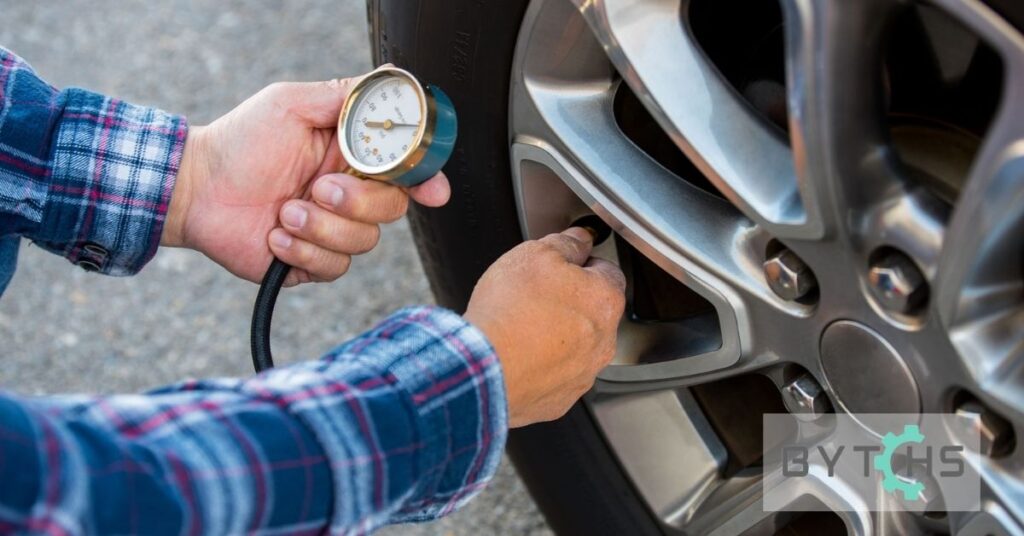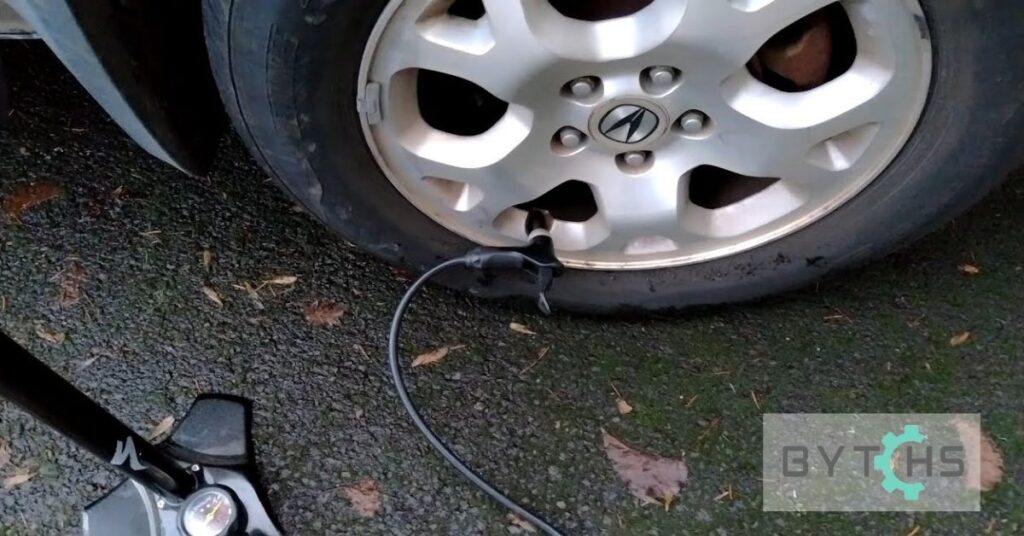Inflating a car tire with a bike pump might seem daunting, but believe me, it’s a manageable process! I’ve learned a few tricks along the way that can make this a surprisingly effective way to get a tire road-ready without the hassle of an air compressor. Whether you’re dealing with an emergency flat or just want a DIY way to top off your tires, I’ll guide you through the steps and answer some common questions. Let’s dive in!
Quick Answer:
Yes, you can inflate a car tire with a bike pump! While it takes a bit more effort and time than using a compressor, it’s a handy solution for emergencies and topping off tires at home. Just attach the pump securely, monitor the pressure, and be prepared for a mini workout.
Why You Might Want to Use a Bike Pump for a Car Tire
According to my experience, using a bike pump to inflate a car tire can be a lifesaver. I know many people wonder if it’s even possible, but if you’re without an air compressor or a gas station, a sturdy bike pump is a fantastic backup tool. Here’s why it’s worth considering:
- In Case of Emergencies: Flat tire with no compressor? A bike pump can help you get enough pressure in the tire to reach the nearest repair shop.
- Convenience of Home Maintenance: Keeping tire pressure in check at home saves time and money.
- Cost-Effective Solution: Instead of buying an air compressor, a bike pump can do the trick for those occasional top-offs.
- A Little Extra Exercise: Pumping a tire by hand is a decent workout (especially for your arms!), so if you don’t mind a bit of physical activity, this method could be for you.
Also Read: Why do my RC car’s tires wear out so fast?
Step-by-Step Guide to Inflating a Car Tire with a Bike Pump
Based on what I’ve tried myself, here’s a practical, step-by-step breakdown to make sure everything goes smoothly.
Step 1: Gather Your Tools and Check the Tire Pressure
First things first, you’ll need to know your tire’s PSI (pounds per square inch). You’ll find this number on the tire’s sidewall or in the car’s manual. Most cars recommend between 30-35 PSI. Having the right pressure isn’t just about getting back on the road—it impacts fuel efficiency, tire wear, and overall safety.
You’ll need:
- A high-quality floor bike pump (ideally with a built-in pressure gauge).
- A tire pressure gauge (if your pump doesn’t have one). Trust me, this little tool makes life a lot easier.

Step 2: Attach the Bike Pump to the Tire Valve
This is where you’ll want to ensure a good connection:
- Remove the Valve Cap: Unscrew the dust cap from the tire’s valve and keep it safe.
- Secure the Pump Nozzle: Align the pump’s nozzle with the valve stem. If you’re not familiar, car tires use a Schrader valve (the same as many bike tires). Attach the pump nozzle and lock it in place by lifting the lever.
Pro Tip: You may hear a small “hiss” as the nozzle locks in place—this is normal and just indicates the pump is sealing around the valve. If you hear ongoing hissing, though, the pump isn’t fully attached; try adjusting it.
Step 3: Pump Steadily to Inflate the Tire
Once the pump is attached, it’s time to get pumping! Based on my experience, pumping up a car tire manually does take some elbow grease, especially if the tire is very low. Here’s how to approach it:
- Use Steady Strokes: Raise and lower the pump’s handle steadily. It takes a few hundred pumps to reach full PSI for a standard car tire, so think of it as a mini workout.
- Be Patient: Pumping manually will take some time. A good bike floor pump moves a decent amount of air with each stroke, but it won’t be as fast as an electric compressor.
Step 4: Monitor Tire Pressure as You Go
Keeping an eye on the PSI as you pump is crucial. You don’t want to overinflate the tire, which can strain the rubber and affect handling.
- Take Breaks to Check PSI: Every few minutes, use a tire gauge to make sure you’re getting close to the target pressure.
- Release Excess Air if Necessary: If you accidentally go over the target PSI, you can release a bit of air by pressing the valve pin to adjust the pressure.
Insider Insight: If you need to release air, do it carefully. Letting out too much air can mean extra pumping to get back to the right level.
Also Read: Is Driveshaft Play Normal?
Step 5: Repeat for Any Other Tires
Once you’ve got the first tire to the correct PSI, move on to the others if they need it. Maintaining even tire pressure across all tires helps balance tire wear, improves fuel economy, and generally makes for a safer, smoother drive. When you’re done, don’t forget to replace the valve caps.
Video Guide About Using a Bike Pump to Inflate Your Car Tire:
Common Questions People Have About Using a Bike Pump for a Car Tire
Here’s a quick Q&A to address some of the most frequent questions people have about this process:
1. Can You Use a Bike Pump to Inflate a Car Tire?
Yes, absolutely! I’ve done it myself and can confirm it’s entirely possible. Just be prepared for a bit of physical effort if the tire is close to empty.
2. How Long Does It Take to Pump a Car Tire with a Bike Pump?
If the tire is nearly flat, it may take 10-20 minutes of steady pumping. It’s definitely slower than a compressor but manageable in a pinch.
3. Is It Safe to Use a Bike Pump on a Car Tire?
It’s safe as long as you keep an eye on the pressure gauge. Going too high with PSI can strain the tire, so check regularly to avoid overinflating.
4. How Can You Use a Bike Pump for a Car Tire?
Simply follow the same steps you’d use for a bike tire: attach the pump to the Schrader valve, pump steadily, and monitor the PSI.
5. How Do You Inflate a Car Tire with a Bike Pump?
Attach the pump securely, pump consistently, and keep an eye on your target PSI—this is the essential routine for inflating a car tire by hand.
Troubleshooting Tips I’ve Picked Up for Using a Bike Pump on Car Tires
Here are some quick solutions for common issues you might run into:
- Loose Connection: If you’re hearing a lot of air escaping, try repositioning the pump nozzle on the valve.
- Check the Hose for Damage: Older pump hoses can crack, leading to air leaks. If this happens, replace the hose or wrap any cracks with strong tape as a temporary fix.
- Rely on a Separate Tire Pressure Gauge: Gauges on some pumps can be inaccurate, so having a separate, reliable tire gauge is always helpful.
Final Thoughts from My Experience
Pumping up a car tire with a bike pump is slower than using a compressor, but it’s a handy skill for emergencies and keeps you self-reliant. In my opinion, it’s well worth keeping a quality bike pump in your car’s trunk as a backup. Plus, it’s a more eco-friendly and budget-conscious choice than relying on electricity or gas station compressors.
This guide should help you feel confident in handling any tire inflation needs with just a bike pump. After all, a little extra workout isn’t a bad thing, and knowing you can manage a flat tire on your own feels pretty empowering!
- Why Does My Car Tire Lose 5 PSI in a Week? - 4 November 2024
- How Do You Inflate A Car Tire With A Bike Pump? A Practical Guide in 5 Easy Steps - 30 October 2024
- Why do my RC car’s tires wear out so fast? Tips to Maintain Performance Over Time - 18 October 2024



